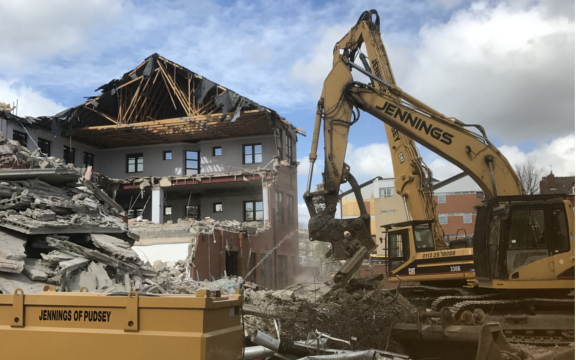
16 Jul What type of demolition do I need for my building?
All demolition projects are unique and require their own combination of demolition techniques. Sometimes, the most cost-effective and efficient way to start demolishing a building is with a wrecking ball and bulldozers. Other times, a building needs to be carefully de-built by hand to save period building materials.
The type of building being demolished, its size, scale of surrounding site and the local environment are all key consideration points for us when we survey a project. It takes an experienced head to identify health and safety and environmental risk and control that risk by recommending the right demolition techniques.
To give you an example, a concrete office block might appear to be a prime candidate for sending the bulldozers in. However, during a survey of the surrounding site we might discover a stream running through it. We would opt for a careful demolition technique, if possible, to prevent contamination while getting the job done.
Implosion
Implosion is the fastest and most effective way to bring down a building. It involves placing blasting charges on internal building supports to knock them out. This causes the building to collapse. If done correctly, the building should collapse into a (relatively) neat pile of rubble that can be swept up and sent off to be recycled.
Implosion is best-suited to big buildings. Multi-storey car parks, office blocks, apartments, high-rises, mansions – these buildings are prime candidates.
For this demolition technique to be successful, engineers have to study a building’s blueprints and identify support structure. The only risk to health comes from the dust that is generated from the implosion. If done correctly, it’s a clean technique.
Mechanical demolition
Sometimes, you need a hammer not a chisel. Where this is the case, wrecking balls are perfect tools. These are best-suited to large scale coarse demolition, i.e. projects that don’t require a hint of delicacy to get the job done. Wrecking balls range from 450kg to over 5,000kg, with heaver balls reserved for industrial projects.
Wrecking balls are used to start demolishing a building. They do a great job at smashing up the main structure and bringing it to the ground.
Once a wrecking ball has had its way, tracked dozers are used to smash up lower sections of a building. These are versatile tools that can be configured with blades, loaders or rippers to break up brick, mortar and concrete. They can also be used to collect the debris.
Demolition by hand (de-building)
De-building by hand is a time-intensive and skilled job. This demolition technique is a soft, delicate one that preserves the materials of the old building. Period stonework, marblework, ironwork and woodwork can be preserved this way. Brick by brick, the building comes down in a controlled and managed way.
Deconstruction by hand can also be combined with mechanical demolition. This is common in period buildings that have been modernised. Here, the period section of a property is typically de-built by hand while the modern section is smashed down.
De-building by hand is also common on residential projects. Mechanical demolition may not be possible due to proximity with public spaces. Where this is the case, the top section of a building might have to be de-built by hand.
Collecting the debris
It’s also important to cover collecting the debris. Every single demolition project generates tons of rubble. This rubble has to be collected in some way. Due to the sheer weight of concrete blocks, larger rubble has to be removed by machine. This is loaded onto trucks as it is, or it’s crushed onsite using a specialist machine.
Crushing the rubble onsite is efficient because it makes the rubble smaller and more manageable. In simple terms, it means more of the crushed rubble can fit onto a truck than the uncrushed rubble. This makes transporting easier.
A lot of the time, the crushed rubble can be reused in construction. For example, to create new roads and new concrete. Where this is the case, the rubble will be sent off to specialist sorting and recycling centres. This puts the material back into circulation and ensures it isn’t a burden on the environment and sent to landfill.
Talk to our experts about demolition
Jennings has provided demolition services in Leeds and Hull for over fifty years. Talk to our experts for advice and recommendations. Call us on 0113 255 8919 for our Leeds office, or on 01482 346 650 for our Hull office. Thank you.


No Comments